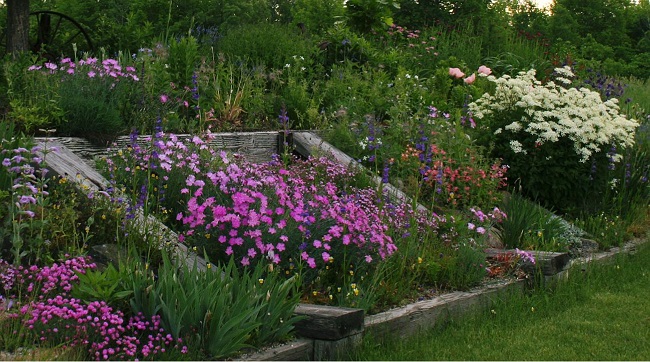
Growing your own food doesn’t have to be rocket science. In the words of Confucius, “Life is really simple, but we insist on making it complicated.” I’m about to share a widespread, age-old gardening technique which is also cutting-edge horticulture for the high-tech urban grower. Instead of planting in the ground, make a pile of dirt and plant in the pile. I’m not joking- that’s it.
The raised bed garden is a simple concept that will help increase the yield of just about any outdoor vegetable or herb. The secret lies in providing a rich soil and then controlling the soil’s interaction with water. Water is an essential element of all life but also a source of soil erosion, soil compacting, soggy soil, seed rot, and pests. The raised bed helps plants access the water they need and remove the water they don’t.
Building a raised bed does not need to be complicated or expensive. A simple 4’ x 6’ bed that includes quality, rot resistant wood, can be completed in a few hours for a minimal amount of money. If you have access to stones, leftover brick, concrete blocks, old tires, or scrap wood/pallets you can build a permanent bed for next to nothing. (If you choose to use recycled wood, predrill the holes for easy assembly and use a little linseed oil to make the wood last.) Beds can be built in any shape if they’re open on the top and bottom. The container is optional. You can even just mound up soil or stack hay bales in a square, but these options will require you to rebuild every spring as the hay decomposes and the soil washes away without anything to contain it.
A basic plan is to make your bed no wider than 4’ across so you can tend it without stepping in it. Ideally, the dirt pile should be deep enough that the plants are at least 12-18” above the surrounding area. Starting with clean, fresh soil is the easiest way to avoid weed seeds and pests. OMRI listed soil that is heavy in compost can be found at almost any garden center. If you’ve been given clay or sand to work with you will want to build completely on top of the native soil. Other soil types can be worked into the bed, but you will want it to be made up of as much compost as possible amended until the soil is loose and easily releases water. The only real maintenance a permanent bed should require is a fresh layer of compost/organic materials once a year.
The raised bed offers more returns than one might expect from simply piling dirt. Raised beds can provide a lush garden regardless of limited space or poor soil. The raised bed warms up and dries out faster in the spring allowing you to enjoy a longer growing season than your ground-growing neighbors. Raised bed gardeners are also able to grow plants closer together and expect a larger yield per square foot than traditional gardeners. All of this while reducing the amount of work required to plant, weed, and harvest. Let’s think simple.
Angela Lundmark is a freelance writer that enjoys gardening outdoors and indoors.
Related Articles & Free Email Newsletter
A Secret Bed Building and Potting Soil Recipe
How to Expand Your Planting Space



Comment here